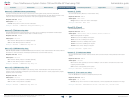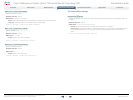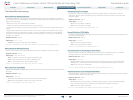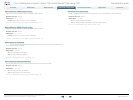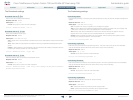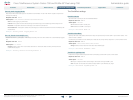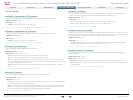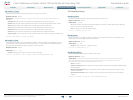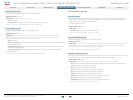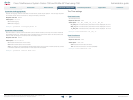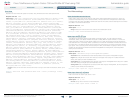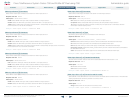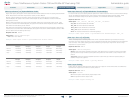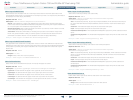
55
Cisco TelePresence System Codec C90 and Prole 65” Dual using C90 Administrator guide
D14635.05 Prole C90 and Codec C90 Administrator Guide TC4.1, February 2011.
Copyright © 2010-2011 Cisco Systems, Inc. All rights reserved.
www.cisco.com
The SIP settings
SIP Prole [1..1] Authentication [1..1] LoginName
This is the user name part of the credentials used to authenticate towards the SIP proxy.
Requires user role: ADMIN
Value space: <S: 0, 50>
Format: String with a maximum of 50 characters.
Example: SIP Prole 1 Authentication 1 LoginName: ""
SIP Prole [1..1] Authentication [1..1] Password
This is the password part of the credentials used to authenticate towards the SIP proxy.
Requires user role: ADMIN
Value space: <S: 0, 50>
Format: String with a maximum of 50 characters.
Example: SIP Prole 1 Authentication 1 Password:
SIP Prole [1..1] DefaultTransport
Select the transport protocol to be used over the LAN.
Requires user role: ADMIN
Value space: <UDP/TCP/TLS/Auto>
UDP: The system will always use UDP as the default transport method.
TCP: The system will always use TCP as the default transport method.
TLS: The system will always use TLS as the default transport method. For TLS connections a SIP
CA-list can be uploaded using the web interface. If no such CA-list is available on the system then
anonymous Die Hellman will be used.
Auto: The system will try to connect using transport protocols in the following order: TLS, TCP,
UDP.
Example: SIP Prole 1 DefaultTransport: Auto
SIP Prole [1..1] TlsVerify
For TLS connections a SIP CA-list can be uploaded using the web interface.
Requires user role: ADMIN
Value space: <On/Off>
On: Set to On to verify TLS connections. Only TLS connections to servers, whom x.509 certicate
is validated against the CA-list, will be allowed.
O: Set to O to allow TLS connections without verifying them. The TLS connections are allowed
to be set up without verifying the x.509 certicate received from the server against the local CA-
list. This should typically be selected if no SIP CA-list has been uploaded.
Example: SIP Prole 1 TlsVerify: Off
SIP Prole [1..1] Outbound
The client initiated connections mechanism for rewall traversal, connection reuse and redundancy.
The current version supports http://tools.ietf.org/html/draft-ietf-sip-outbound-20.
Requires user role: ADMIN
Value space: <On/Off>
On: Set up multiple outbound connections to servers in the Proxy Address list.
O: Connect to the single proxy congured rst in Proxy Address list.
Example: SIP Prole 1 Outbound: Off
SIP Prole [1..1] Proxy [1..4] Address
The Proxy Address is the manually congured address for the outbound proxy. It is possible to use a
fully qualied domain name, or an IP address. The default port is 5060 for TCP and UDP but another
one can be provided. If Outbound is enabled, multiple proxies can be addressed.
Requires user role: ADMIN
Value space: <S: 0, 255>
Format: Compact string with a maximum of 255 characters. An IP address that contains letters
(192.a.2.0) or unvalid IP addresses (192.0.1234.0) will be rejected.
Example: SIP Prole 1 Proxy 1 Address: ""
SIP Prole [1..1] Proxy [1..4] Discovery
Select if the SIP Proxy address is to be obtained manually or by using Dynamic Host Conguration
Protocol (DHCP).
Requires user role: ADMIN
Value space: <Auto/Manual>
Manual: When Manual is selected, the manually congured SIP Proxy address will be used.
Auto: When Auto is selected, the SIP Proxy address is obtained using Dynamic Host Conguration
Protocol (DHCP).
Example: SIP Prole 1 Proxy 1 Discovery: Manual
Contents
Contact us
Introduction
Advanced conguration
Password protection
Web interface
Appendices
Advanced conguration



